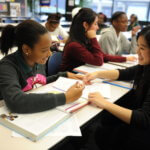The Bush School: Helping pupils get creative remotely
Bringing children together online to showcase their ideas through tech
Design thinking isn’t something you imagine 11-14 year olds doing.
But when the pandemic set in during early 2020, Technology teacher Tracy Asplen of The Bush School, Seattle, thought it could be a great way to bring children together to get creative from home.
Teachers in the school’s art department, which comprises Visual Arts, Music, Drama, and Technology, decided that students would focus on one subject per week.
Tracy spent two non-consecutive weeks with all 180 students, and wanted to run a unifying project, where they could practise their technology skills and learn something new.
Having tried out design thinking with a small group of students earlier in the year, Tracy decided to use Sprintbase to run a sprint with the group to tackle real life middle school appropriate scenarios.
How they did it
Before kicking off the project, Tracy created a survey listing a series of challenges relating to life in lockdown that the children might be interested in tackling. These were:
- How might we make grocery shopping safer during a global pandemic?
- How might we encourage people to cook with things they already have in their pantries and refrigerators?
- How might we encourage people to engage in and track physical fitness during quarantine?
- How might we encourage people to develop new hobbies?
- How might we encourage people to safely check on their neighbours?
- How might we encourage people to only order essential items online?
- Students rated how important each issue was to them, so that Tracy could assign them to work in teams on the projects they most cared about.
As the children had not used Sprintbase before, Tracy took the time to warn them that communications would come from the platform. She also made a video explaining what she had planned, and shared it via Sprintbase, on their school portal, and email to make sure everybody could see the instructions.
Tracy also created a test sprint before the project kicked off, walked students through the platform, and was then available during class times to answer questions.
Students worked in 18 teams of 10-11 students. One of the benefits of working through Sprintbase, was that the children could participate at different times. Tracy set deadlines for them to meet each day, but they could do the work when it suited them.

The results
Teams were given the option to make prototypes for their ideas in a number of different formats, including creating an infographic, building an app, developing a public service announcement, and creating video games.
The student teams came up with loads of great ideas – from cookbooks to help people create meals at home that meet everybody’s dietary requirements, to jingles to encourage people to check in on residents in their neighbourhoods. One group made a video game to help people identify hobbies they could enjoy during lockdown.
As well as the positives of going through the design thinking process, generating ideas and creating tech prototypes, there were other benefits to going through this process.
It allowed Tracey to get to know students better and see different sides to them. For example, more introverted children had the chance to be creative in their own way and time. Some students really threw themselves into their challenge and gave a lot of thought to how their idea could help people during this difficult time.
Four things The Bush School students learned from this process
- The value of collaboration – It’s so important not to work in a vacuum. Having children share ideas, reply to each other, and vote on suggestions was really valuable.
- What it means to be part of a group – and achieve new, exciting things together.
- That their opinions matter – I wanted them to see that their ideas are just as important as adults’.
- That they can solve problems – When they put their minds to it and challenge themselves, they can come up with great solutions.
Tips for running a virtual sprint with school students
- Be organised – It takes a bit of time to personalise the challenge you want school students to tackle. Sending out a survey helped to sow the seed and get useful information to inform our project.
- Feedback is key – Sometimes students would share ideas for things that already existed, so you need to be available to encourage people to think a bit deeper.
- Offer different prototyping options – It works well to let people create prototypes according to their preferences and skillsets. Sharing a nice list of options gave students choice and made them feel comfortable showcasing their ideas.
Similar stories

Deloitte + Sprintbase: Taking global collaboration to a new level
A Global Design Sprint ‘Relay’ with Deloitte

Experience a multi-week virtual design project in less than 2 hours
The Power of Going Virtual: Better solutions, faster with remote teams

How McGill University used Sprintbase to engage students online
Moving design thinking learning online at pace






